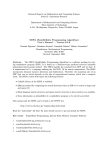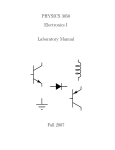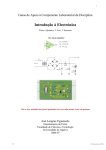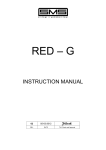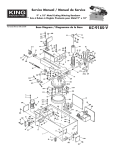Download User's guide for the ROC-HJ solver: Finite Differences and Semi
Transcript
User’s guide for the ROC-HJ ∗ solver:
Finite Differences and Semi-Lagrangian methods
November 2014
Version 2.0 †
Current developers : O. Bokanowski, H. Zidani, J. Zhao, A. Desilles.
1
Problem solved
This is a c++ MPI/OpenMP library for solving d-dimensional Hamilton-Jacobi-Bellman
equations by finite difference methods, or semi-lagrangian methods. First order and second
order HJ equations time-dependent or steady equations can be solved. More precisely, the
equations considered are of the following type.
1.1
Evolutionary case
The problem is to find u = u(t, x) solution of
∂u
∂t + λ(x)u(x) + H(t, x, u(x), ∇u) = 0,
u(t, x) = gbord (t, x), x ∈ ∂Ω,
u(0, x) = u (x), x ∈ Ω
0
x ∈ Ω,
t ∈ [0, T ],
t ∈ [0, T ],
(1)
Q
where Ω is a domain of Rd of the form di=1 [ai , bi ], and gbord and u0 are given functions.
(other boundary conditions are possible). The function H(t, x, p) can be defined either
directly or as follows 1
H(t, x, ∇u) := max − f (t, x, a) · ∇u − `(t, x, a) ,
(2)
a∈A
∗
Reachability, Optimal Control, and Hamilton-Jacobi equations
Including a SL solver for second order HJ equations, see Section 7.
1. maxa∈A (· · · ) can be also mina∈A (· · · )
†
1
Q A
where A is a set of controls, of the form ni=1
[αi , βi ], or 2
H(t, x, ∇u) := max min − f (t, x, a, b) · ∇u − `(t, x, a, b) ,
a∈A b∈B
(3)
Q A A A
Q B B B
where A and B are control sets of the form ni=1
[αi , βi ] and nj=1
[αj , βj ].
Some second order equations can also be treated, of the following type
0=
∂u
+ λ(x)u +
(4a)
∂t
1
max −`(t, x, a) + r(t, x, a)u − b(t, x, a) · ∇u − T r(σ(t, x, a)σ(t, x, a)T D2 u)
a∈A
2
t ∈ [0, T ], x ∈ Rd ,
u(0, x) = u0 (x),
x ∈ Rd
(4b)
Q A
[αi , βi ]),
where A is some non empty compact subset of Rm (m ≥ 1), (of the form ni=1
d
b(t, x, a) is a vector of R , r(t, x, a) and `(t, x, a) are real-valued, and σ(t, x, a) is a d×p real
matrix (for some p ≥ 1). This problem is linked to the computation of the value function
of stochastic optimal control problems.
1.2
Steady equations
The problem is to find u = u(x) solution of
λ(x)u(x) + H(x, u(x), ∇u(x)) = 0,
x ∈ Ω,
(5)
with H given directly or in the form of (2) (or as in (4a) for second order equations), the
Q
function λ(x) should be strictly positive, Ω an hyperrectangle of Rd of the form di=1 [ai , bi ].
Equation (5) is complemented by boundary conditions as follows :
u(x) = gbord (x),
x ∈ ∂Ω.
It is possible also to solve (5) in a subdomain C. In that case the set C should be defined
such that C := {x, gdomain (x) < 0} (equivalently, Ω\C = {x ∈ Ω, gdomain (x) ≥ 0}), and
the boundary conditions at the border ∂C should be of Dirichlet type, fixed by u0 (x) :
u(x) = u0 (x),
x ∈ ∂C.
In general this equation is solved by using an iterative procedure ("value iteration"), where
the part λ(x)u(x) is treated explicitly (for a FD method) or implicitly (for a SL method). 3
2. maxa∈A minb∈B (· · · ) can be also mina∈A maxb∈B (· · · )
3. For steady equations, the scheme is based on the following iteration on n ≥ 0, for a fixed
∆t > 0 :
un+1 (x) − un (x)
+ λ(x)un (x) + h(x, un (x), Dun (x)) = 0, x ∈ C,
∆t
2
2
Compilation and execution (under GCC and CMake)
In order to make the program works, the c++ compiler GCC and the build system CMake
are proposed to help the compilation process. The source files are typically in the directory
src/. User’s data files are typically in the directory data/.
For deeper informations, we redirect the user to the following links :
http ://gcc.gnu.org/install/
http ://www.cmake.org/cmake/resources/software.html
Building the Makefile : cmake . (do not forget the "dot")
Compilation : make (source .cpp files are generally in the directory src/)
Options : make clean (cleaning some .o files), make cleanall.
Other : "./clean" to first erase all unecessary files (can be done before the "cmake ."
command.)
Sequential code Execution (basic) :
./exe
Execution (with options)
./exe -nn NN -nc NC
Options :
• option -nn NN : number of mesh points per dimension
• option -nc NC : number of controls per command’s dimension.
where h(x, un (x), Dun (x)) corresponds to some numerical approximation of H(x, un (x), ∇un (x)).
Iterations are stopped when kun+1 − un kL∞ is smaller than a given threshold. Therefore we obtain
the following recursion
un+1 (x) = un (x) − ∆t λ(x)un (x) + h(x, un (x), Dun (x)) = 0, x ∈ C.
For the SL method, the iterative scheme is based on an implicit treatment of the λ(x)u(x) term,
and becomes, in the case of (2) :
1
[un ](x + ∆tf (t, x, a)) + `(t, x, a) = 0, x ∈ C.
un+1 (x) = min
a 1 + λ(x)∆t
Here [un ] denotes the Q1 interpolation of un on the spatial grid mesh.
3
OpenMP Some options run with OpenMP. Execution :
./exe -nt nbth
where nbth is the number of threads (typically try nbth=2 or nbth=4).
Parallel code (Parallel MPI version only)
Execution : mpirun -n MPI_PROCS ./exe -nn NN -nc NC -nt OMP_THREADS -nd MPI_GRID_DIM
where
• MPI_PROCS : number of MPI processors (default = 1)
• NN : number of mesh points per dimension
• NC : number of controls per command’s dimension
• OMP_THREADS : number of OpenMP threads (default = 1)
• MPI_GRID_DIM : dimension of the MPI mesh grid decomposition (2 or 3) (default
= 2).
Example 1 : mpirun -n 2 ./exe -nn 200 will execute the program with 2 MPI processors
and 200 mesh points per dimension.
Example 2 : mpirun -n 64 ./exe -nn 500 -nc 10 -nt 4 -nd 2 will execute the program with MPI_PROCS=64 MPI processors, NN=500 points per dimension, NC=10 controls
per command’s dimension, OMP_THREADS=4 OpenMP threads, and MPI_GRID_DIM=2, the
dimension of the MPI mesh grid decomposition.
Example 3 : mpirun -n 1 ./exe -nn 500 -nc 10 -nt 4.
The OpenMP parallelization is working for Semi Lagrangian and Finite Difference methods. When using only this method, one can indicate only one process for the mpirun
command (for instance mpirun -n 1 ./exe -nt 4 for using 4 threads) or, equivalently,
use ./exe -nt 4.
3
User’s parameters
The file data/data_simulation.h is the main user’s input file and contains the parameters that define the equation to be solved. It can include an other data_xxx.h file (see
basic examples data_basicmodel.h, data_FD_2d_ex1_basic.h). It contains also parameters relative to the output during the execution saving data and data post-treatment (see
paragraph "Output parameters").
• NAME : name of the problem
• DIM : dimension d of the problem
Choice of the solver
• METHOD ∈ {MDF,MSL} :
4
MDF : Finite Difference Method
MSL : Semi-Lagrangian Method
Stopping criteria
• T : terminal time
• MAX_ITERATION : to stop the program when this maximum number of iterations is
reached.
• EPSILON : for stopping criteria. If set to 0, do nothing. If set to some positive value
, then the program will stop at iteration n + 1 as soon as
kv n+1 − v n kL∞ := max |vin+1 − vin | ≤ .
i
(the L∞ error between two successive steps is smaller than ).
Finite Difference Method This method is used when METHOD=MDF, and it utilizes :
• COMMANDS ∈ {0,1,2} :
This decides how we define the Hamiltonian function H(x, p) (using the "commands"
or not).
1 : the commands are used in the definition of the numerical hamiltonian, as in (2).
The program will use a numerical hamiltonian function corresponding to a finite
difference approximation of H(x, ∇u) = max(−f (x, α).∇u − `(x, α)). Examples
α
are given in data_basicmodel.h (rotation), or data_FD_2d_ex1_basic.h (eikonal
equation).
2 : the commands are used in the definition of the numerical hamiltonian, as in (3).
The program will use a numerical hamiltonian function corresponding to a finite
difference approximation of (for instance) H(x, ∇u) = max min(−f (x, α, β).∇u −
α
β
`(x, α, β)).
0 : an Hnum function must be directly defined by the user ; it has to be a numerical
hamiltonian corresponding to H(x, p). Examples are given in data_advancedmodel.h,
data_FD_2d_ex1_advanced.h.
If
•
•
•
COMMANDS=1, we need also to define
function dynamics : f (x, α)
function distributed_cost : `(x, α)
Q
a set of commands corresponding to the discretization of a cube i=1,nc [αi , βi ], defined by cDIM (dimension nc of the set of controls), NCD[cDIM] (number of commands
per direction) UMIN[cDIM], UMAX[cDIM] (min and max values αi and βi of the commands in each direction).
If COMMANDS=2, we need to define
5
• function dynamics2 : f (x, a, b, t)
• function distributed_cost2 : `(x, a, b, t)
Q
• two sets of commands A and B, corresponding to the discretization of A ≡ i=1,nA [αiA , βiA ]
Q
and B ≡ i=1,nB [αiB , βiB ]. The parameters cDIM, cDIM2 will correspond to nA and
nB , the dimension of each set of controls), NCD[cDIM] is the number of commands
per direction, and UMIN[cDIM], UMAX[cDIM] are the min and max values of αi and
βi of the commands in each direction.
If COMMANDS=0, we need to define
• function Hnum : a first order numerical Hamiltonian.
• function
compute_Hconst.
This function must define d constants which are bounds
∂H
for ∂pi (x, p, t) (i = 1, . . . , d), for x ∈ Ω and for possible gradient values p and time t.
This is then used to set the time step ∆t in order to satisfy a CFL condition. These
constants may also be used in the function Hnum.
(The user may also define directly the constants ci =Hconst[i] and initialize the
previous function accordingly.)
Then, in all cases, we have also to set the scheme discretisation parameters :
• TYPE_SCHEME ∈ {LF,ENO2} : type of spacial discretization
LF : Lax-Friedrich scheme (first order scheme)
ENO2 : ENO scheme of second order to approximate the derivatives ∇u
• TYPE_RK ∈ {RK1,RK2,RK3} : Time discretization by a Runge-Kutta method of order
1, 2 or 3.
RK1 : RK method of order 1
RK2 : RK method of order 2
RK3 : RK method of order 3
Semi-Lagrangian Method This method is used when METHOD=MSL. It assumes that :
H(x, ∇u) ≡ max(−f (x, α).∇u − `(x, α)).
α
Then
•
•
•
it needs to define :
function dynamics : dynamics f (x, α)
function distributed_cost : cost function `(x, α)
TYPE_SCHEME ∈ {STA,EVO} :
STA : stationnary case, for solving (5). In this case, the scheme is based on an
iterative procedure.
EVO : dynamic case, for solving (1)
ORDER : this value is set to 1 for solving first order equations of type (1) (see other
section below for second order HJB equations).
6
• TYPE_STA_LOOP ∈ {NORMAL, SPECIAL} : Mesh loop order during mainloop for the
stationary case.
NORMAL : normal ordering loop
SPECIAL : special ordering loop (makes 2d loops at each iteation, modifiying the
current values of the data v during each loop)
• TYPE_RK ∈ {RK1_EULER,RK2_HEUN,RK2_PM} :
RK1_EULER : RK1 Euler scheme
RK2_HEUN : RK2 Heun scheme
RK2_PM : RK2 Mid-point scheme
• INTERPOLATION ∈ {BILINEAR,PRECOMPBL,DIRPERDIR} :
BILINEAR : (default value) bilinear interpolation (Q1 interpolation)
PRECOMPBL : precompute the interpolation coefficients (to use with tiny mesh sizes)
DIRPERDIR : another interpolation method
• COMPLEMENTS :
P_INTERMEDIATE : number of intermediate timesteps to go from tn to tn + ∆t for
computing a caracteristic for a given RK method.
ORDER ∈ {1,2} : decide treatement for first order HJ equation or for second order
HJ equation.
Discretization parameters
• ND[DIM] : tab containing the size mesh in each direction (cartesian mesh)
• MESH ∈ {0,1} : default is 1. It utilizes ND[i]+1 points in direction i. (If MESH=0
the mesh points are at the center of the mesh cells, and there are ND[i] points in
direction i)
• DT : the time step used for the solver, for the evolutive equation.
- For the finite difference approach, if DT=0, then time step DT is computed so that
the CFL condition be satisfied, that is, such that
DT * (Hconst[0]/dx[0] + Hconst[1]/dx[1] + ... ) <= CFL
where the CFL number belongs to [0, 1]. Otherwise, if DT>0, then the value DT is
used for the time step.
- For the semi-lagrangian approach and for the stationnary equation, the parameter
h in the iterative procedure is also set to DT
Other parameters for the definition of the problem The parameters are :
• XMIN[DIM], XMAX[DIM] : the boundary (ai , bi ) of the domain in each direction
• PERIODIC[DIM] : each componant set the periodicity for each direction
1 : direction is periodic
0 : direction is not periodic
• BOUNDARY ∈{0,1,2} : If set to 0, no boundary treatment. If set to 1 : Utilizes Dirichlet
7
•
•
•
•
•
boundary conditions for each direction d such that PERIODIC[d]=0. The boundary
value is given in the user-defined function g_bord. If set to 2 : Utilizes a special
vxi xi = 0 boundary condition for each direction d such that PERIODIC[d]=0 (note
that this special approximation can be unstable).
function v0 : the initial data
function Vex : if known, the user can put the exact solution of the problem here.
integer EXTERNAL_v0 ∈ {0,1} : if 0 initialize with function v0, otherwise initialize
with last VF.dat values (located in OUTPUT/VF.dat) 4
COMPUTE_IN_SUBDOMAIN ∈ {0,1} : determines if subdomain computations should be
done, so that the evaluation of un+1 (x) is done only at grid mesh point x such that
gdomain (x) < 0 .
function g_domain(x) : function used to define the subdomain.
Obstacle terms Instead of solving ut + H(t, x, u, ∇u) = 0, the solver can also treat HJ
obstacle equations such as
min
∂u
+ H(t, x, u, ∇u), u − g(t, x)
∂t
= 0.
(6)
where g(t, x) is defined by the user. In particular it forces to have u(t, x) ≥ g(t, x) in the
case of (6).
Also, the following obstacle equations can be considered :
∂u
max
+ H(x, ∇u), u − g˜(t, x) = 0
(7)
∂t
or
max
min
∂u
+ H(x, ∇u), u − g(t, x) , u − g˜(t, x) = 0,
∂t
(8)
where g˜(t, x) is used-defined. We will have u(t, x) ≤ g˜(t, x), in the case of (7), or u(t, x) ∈
[g(t, x), g˜(t, x)] in the case of (8).
For this, the following parameters are used :
• OBSTACLE ∈ {0,1}
0 : no obstacle g taken into account.
1 : Equation (6) is treated, with the obstacle g .
• function g_obstacle
• OBSTACLE_TILDE ∈ {0,1}
0 : no obstacle g˜ taken into account.
1 : Equation (7) is treated, with the obstacle g˜ .
• function g_obstacle_tilde
4. Or OUTPUT/VF_PROCxx.dat values if parallel MPI is used.
8
• In the case we set OBSTACLE=1 and OBSTACLE_TILDE=1 then (8) is treated, and both
functions g and g˜ must be defined. (The obstacle functions should satisfy g(x) ≤ g˜(x)
in order to avoid undesidered results).
Output parameters (output files are generaly contained in the directory OUTPUT/)
• COMPUTE_MAIN_LOOP :
1 : the main computational loop (iterative scheme) is called
0 : the main loop is not called, only data initializations and savings are performed.
• COMPUTE_VEX∈{0,1} : will save a VEX.dat file.
1 : if the exact solution is given by the user (using function Vex)
0 : no saving.
In particular it will compute errors (see below) relatively to this value.
• COMPUTE_TMIN∈{0,1} : will compute file tmin.dat which contains the first time
tn ∈ [0, T ] (or some P 1 interpolant) such that v(tn , x) ≤ 0 (Set the value to INF=1.e5
otherwise.)
• PRECOMPUTE_COORD :
1 : precomputes the coordinates : faster computations but more memory demanding.
0 : no precomputations.
• SAVE_VFALL ∈ {0,1} : to save the value of v each SAVE_VFALL_STEP iterations (into
files VFxx.dat).
• FORMAT_FULLDATA ∈ {0,1} : if set to 0, to save only the value at grid mesh points
for files such as VF.dat
• CHECK_ERROR ∈ {0,1} : to compute error every CHECK_ERROR_STEP steps (L∞ and
L1 error computations) Errors are relative to the Vex function. Error are computed
only in the region of points x such that |Vex(t,x)|<C_THRESHOLD 5
• COUPE_DIMS[DIM], COUPE_VALS[DIM] :
- list of integers ni (0 or 1) to define the two variables used for the cut.
- list of values (ci or 0.) to define the position of the cut. The values ci are used only
when ni = 0.
- The output is in the file output.dat
- Example : COUPE_DIMS[DIM]={1,0,1} and COUPE_VALS[DIM]={0.,0.5,0.} define
a cut in the plane x2 = 0.5.
Parameters for trajectory reconstruction The dynamics used is the one defined
in dynamics.
5. For the moment, C_THRESHOLD is defined in src/main.cpp.
9
The following parameters are for control discretization (they are similar to the one used in
the case COMMANDS=1 or COMMANDS=2).
– cDIM : dimension of the control (default is 2)
– NC : total number of commands
– NCD[cDIM] : tab indicating the number of discretisation points for each control u[i].
– UMIN, UMAX : bounds for each control parameter
Then the following more specific parameters are used :
– TRAJPT : ∈ {0,1} : set to 1 for trajectory reconstruction, 0 otherwise.
– initialpoint[DIM] : coordinate of initial point x0 for trajectory reconstruction.
– TRAJ_METHOD : method of reconstruction : 0 if based on minimal time (utilizes
tmin.dat), 1 if based on the value function (utilizes VFxx.dat files).
– time_TRAJ_START : starting time t0 used in the case TRAJ_METHOD=1. Can be any
value in [0, T [. The program will construct an approximated trajectory such that
y(t)
˙ = f (t, y(t), α(t)), t ∈ [t0 , T ], and starting with y(t0 ) = x0 as initial point. 6
– Note that several trajectory reconstructions can be obtained by setting TRAJPT≥ 1,
equal to the desired number of trajectories, and then initialpoint[TRAJPT*DIM]
should contain list of corresponding points.
– If TRAPJT=0 then one should define accordingly initialpoint[DIM]={}.
4
Output files
Output files are generaly contained in the directory OUTPUT/
• OUTPUT/VF.dat contains the final u at the end of the computation. The file is structured as follows, on each line (case FORMAT_FULLDATA=1) :
i1
i2
....
id
val
where val corresponds to the value u(T, x) at mesh point x = (xi1 , . . . , xid ).
In the case FORMAT_FULLDATA=0, on each line, in the same order, only the value
val
will be present in the file.
• OUTPUT/VEX.dat contains the final value as programmed in Vex (if COMPUTE_VEX=1).
• OUTPUT/coupe.dat (and coupeex.dat) can be obtained in the same way, for a problem in dimension d ≥ 3 and when we make a "cut" in some particular subspace
with some given coordinates, and that we want to visualize the results. See paragraph "Output parameters" for using COUPE_DIMS and COUPE_VAL. This is typically
used to make a 2d cut (see for instance example data/data_FD_3d.h).
6. if V¯ (tn , x) is the value function at time tn , attemp to reconstruct a trajectory such that
inf a V¯ (tn+1 , ytan ,x (tn+1 )) is minimal (this in the case OPTIM=MAXIMUM).
10
Furthermore, the following files are related to trajectory reconstruction :
• OUTPUT/traj-n.dat : in case TRAJPT≥ 1, corresponds to the trajectory number n.
Each lines has the form
x1 x2 ... xd a1 ... ap t
where xi are the coordinates of the point at time t, and aj the corresponding control
parameters.
• OUTPUT/successTrajectories.dat Each line n of this file has the form
x1 x2 ... xd t success
and indicates weither the trajectory number n was successfull or not (success=1 or
0) and shows the corresponding terminal coordinates (xi) and time t of the last
constructed point.
5
Graphic outputs
Matlab : the file OUTPUT/output_view.m can be executed by typing ’output_view’
in the Matlab’s user interface (we advise to first set the current Matlab’s directory to
OUTPUT/). aome parameters are given below :
For the first figure :
• level_set : a level set value.
• PLOT_CONTOUR∈{0,1} : if set to 1, will plot contours of the output with level_set
value.
• PLOT_REACHABLE∈{0,1} : if set to 1, will plot the 2d set of points where output value
is ≤ level_set).
This plot is based on the output value which is in the file VF.dat for DIM=2, and a priori
in the file coupe.dat for DIM>2.
For the second figure :
• PLOT_3d∈{0,1} : set this parameter to 1 in order to obtain a 3d graph of the result.
• PLOT_TMIN∈{0,1} : (default is 0). Set this parameter to 1 in order to obtain a 3d
graph of the minimal time (to reach a target). Will then use output tmin.dat, and
will draw several contour plots ranging from 0 to T (plotting tmin.dat is only ok
for DIM=2).
Also for both figures,
• AXIS_EQUAL∈{0,1}, if set to 1, will make "axis equal",
• TRAJECTORY∈{0,1}, if set to 1, will line-plot the list of first two components (x1 , x2 )
of file "trajectory.dat".
11
Paraview : For the moment this option is only working for some 2d/3d cases.
Launch "paraview", then load the files in VTK/* (load tab* and so on).
6
Examples
Rotation example : We give two ways to program an advection-like example, in files
data_basicmodel.h and data_advancedmodel.h. We consider the equation
∂t u + max(0, −f (x) · ∇u) = 0.
with the parameters Ω = [−2, 2]2 , T = 0.5, f (x1 , x2 ) = 2π(−x2 , x1 ). (Hence the Hamiltonian H(x, p, t) = max(0, −f (x) · p).)
In the first way (data_basicmodel.h), we define dynamics
f (x, a) = af (x)
with two control values a ∈ {0, 1}.
In the second way (data_advancedmodel.h), we define the Lax-Friedrich numerical
hamiltonian Hnum associated to H (see (11)).
Eikonal equation : see the files data_FD_2d_ex1_basic.h and data_FD_2d_ex1_advanced.h
The problem solved is
∂t u + c(x, t)k∇uk = 0,
u(0, x) = u0 (x),
x ∈ [−2, 2]d ,
t ∈ [0, T ].
(9)
x ∈ [−2, 2]d ,
(10)
with d = 2, T = 1, here c(x, t) ≡ 1, and with some (radially symetric) initial data u0 (x).
In the file data_FD_2d_ex1_basic.h, a scheme is programmed using a control-discretisation
of k∇uk as follows :
k∇uk ∼
max h(cos(θk ), sin(θk ), ∇ui,
k=1,...,NCD
θk =
2kπ
NCD
where NCD is the number of controls.
In the file data_FD_2d_ex1_advanced.h, a scheme is programmed using a Lax-Friedriech
numerical approximation Hnum associated to H :
d
+
− +
Hnum (x, (p−
1 , p1 ), . . . , (pd , pd ), t) := H(x,
X
p− + p+
, t) −
ci
2
i=1
The exact solution is given for comparison.
12
−
p+
i − pi
2
(11)
7
Second order HJB equations and SL scheme
The problem solved is the following second order Hamilton-Jacobi (HJ) equation
∂u
+ λ(x)u +
(12a)
∂t 1
max − T r(Σ(t, x, a)ΣT (t, x, a)D2 u) − B(t, x, a) · ∇u + r(t, x, a)u − `(t, x, a) = 0
a∈A
2
t ∈ (0, T ), x ∈ Rd ,
u(0, x) = u0 (x),
x ∈ Rd
(12b)
where A is some non empty compact subset of Rm (m ≥ 1), B(t, x, a) is a vector of Rd ,
r(t, x, a), `(t, x, a), are real-valued, and Σ(t, x, a) is a d × p real matrix (for some p ≥ 1).
This problem is linked to the computation of the value function of stochastic optimal
control problems.
It is also possible to consider the corresponding steady equation, that is, equation (12a)
∂u
alone, with no term
.
∂t
The c++ proposed solver is based on an SL method. 7
User
•
•
•
•
inputs :
ORDER = 2
PARAMP (denoted p below) This is in general set to p = d in the scheme.
function Sigma : Σ(x, k, a, t) is the kth column vector of the matrix (Σik (t, x, a))
function Drift : B(x, k, a, t), corresponding to a set a set of p vectors B k (t, x, a)
(k = 1, . . . , p) of Rd such that
X
B k (t, x, a) = B(t, x, a).
k=1,...,p
(For instance the user can set B 1 (t, x, a) = B(t, x, a) and B k = 0, ∀k ≥ 2 ; or B k =
the k-th component of B, the other components beeing set to zero, if p = d).
• function funcR : r(t, x, a)
• function distributed_cost(x,t,x) : distributive cost `(t, x, a).
• function funcL(x) : λ(x) (assuming λ(x) > r(t, x, a) in the case of a steady equation,
that is, equation (12a) alone, with no term ∂u
∂t ).
Scheme definition : we consider the following SL scheme, implemented on the points x
of the grid G. The initialization is done by
v 0 (x) = u0 (x),
x ∈ G.
7. For advanced users : it is programmed in function "secondorder_itSL_evo" that might be
available in the source file HJB_SL.cpp, or in /include/secondorder_itSL_evo.h.
13
For n = 0, . . . NT − 1 (time iterations) (or untill some stopping criteria is satisfied in the
case of steady equations), for all grid points x ∈ G, we consider
v n+1 (x) := min
a∈A
e−r(t,x,a)∆t 1 X n k,,u
[v ](yx (∆t)) + ∆t `(t, x, a) .
1 + λ(x)∆t 2p k=1,...,p
(13)
=−1,1
where the "characteristics" yx (h) can be defined, at iteration t = tn , for some h ≥ 0, for
instance by :
√
yxk,,a (h) := x + B k (t, x, a)h + Σk (t, x, a) h, ∈ {−1, 1}, k = 1, . . . , p.
(14)
Also, [v n ](y) denotes some interpolation of v n at point y (typically Q1 ). 8
8
Source architecture
In this section, we present the architecture used in the implementation of the project. The HJB class represents the main class and the DF and SL classes are sub-classes
of HJB. Commands and Mesh are seperated classes. We remind that the user needs to
code the problem parameters into a C++ header file and to include its name in the file
data/data_simulation.h. For example, if the user data file is called data_myexample.h,
then the line #include "data_myexample.h" (and only this one) must be included in the
file data/data_simulation.h.
8. When using the definition (14), the scheme is of expected order O(∆t) + O( ∆t
) where is of
n
n
the order of the interpolation error kv − [v ]k∞ . For smooth data, this interpolation error is or
order ∆x2 for Q1 interpolation, where ∆x is the spatial mesh size.
14
15




















